
If you’re here, chances are that you’re at least a sci-fi or noir fan and you have at least a passing interest in tabletop RPGs. If you’re a complete newbie to tabletop RPGs, this will be quite the ride though! Either way, Free League Publishing, makers of a variety of TTRPGs like Alien has finally published Blade Runner: The Roleplaying Game! This long-anticipated game started out as a rather successful Kickstarter and now is here for us to gather around the table and take Voight-Kamff tests with!
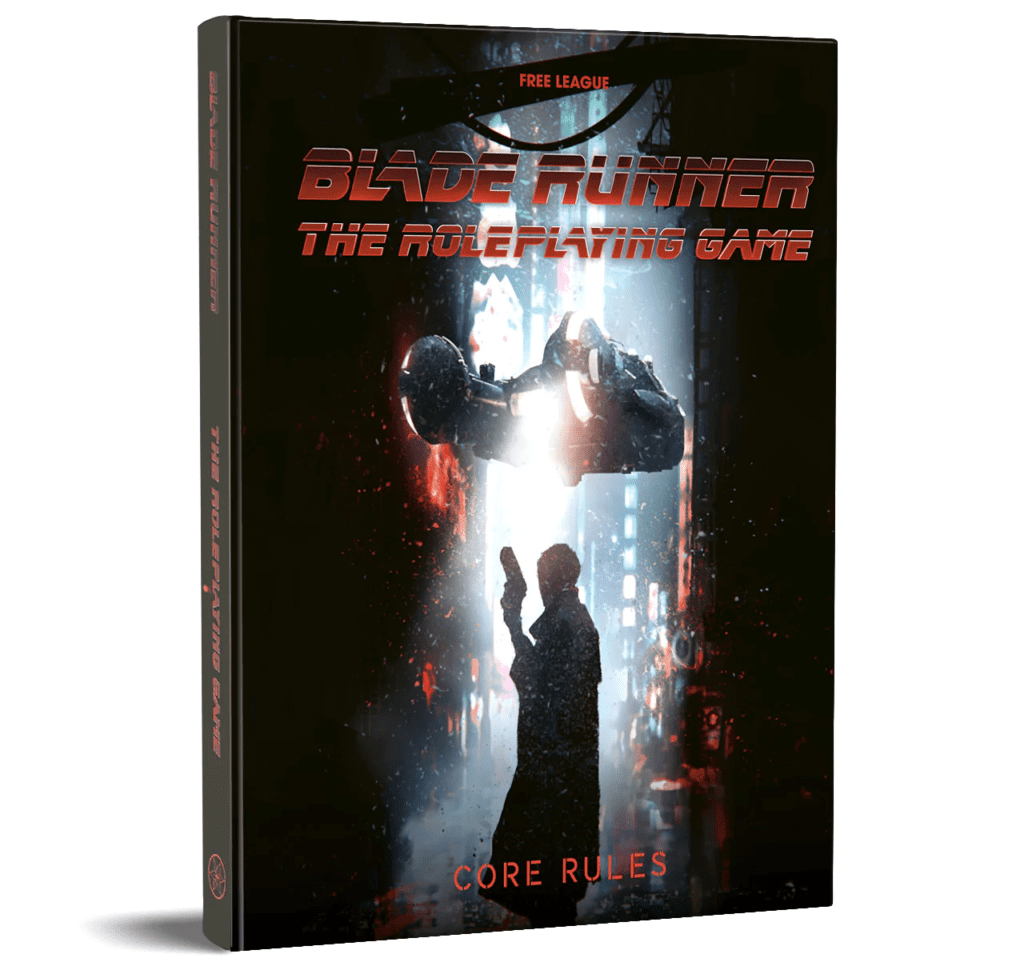
The Core Rules book for Blade Runner: The Roleplaying Game is a thing of beauty, a glossy full-color hardcover, over 200 pages long laying out every facet of the game and adding an absolute ton of detail. This is obviously the work of dedicated fans. The six chapters break down backstory, key concepts and character archetypes, skills and specialties, combat and chases, travel and areas, and the political situation for various groups. Within those sections, the mechanics you’ll need to function in the game are also clearly defined.
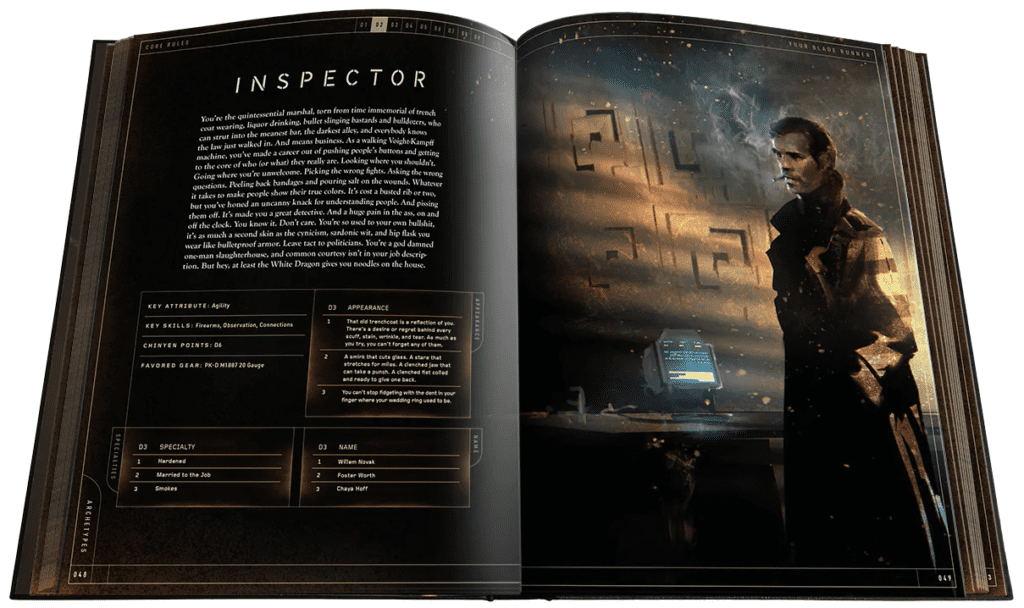
But that’s not the only content available for Blade Runner! There’s also a spectacular Starter Set available. That set has a condensed rule set, the first official Case File for the game, several pre-generated characters, maps and full-color clues including photos, evidence and more, tracking sheets, custom cards to aid in combat and chases, and even a set of custom dice with specialized iconography for the game! You can also get an excellent horizontal Game Runner screen to not only have the salient date for your session at your fingertips without flipping a page but also to provide some excellent artwork as ambiance during play.
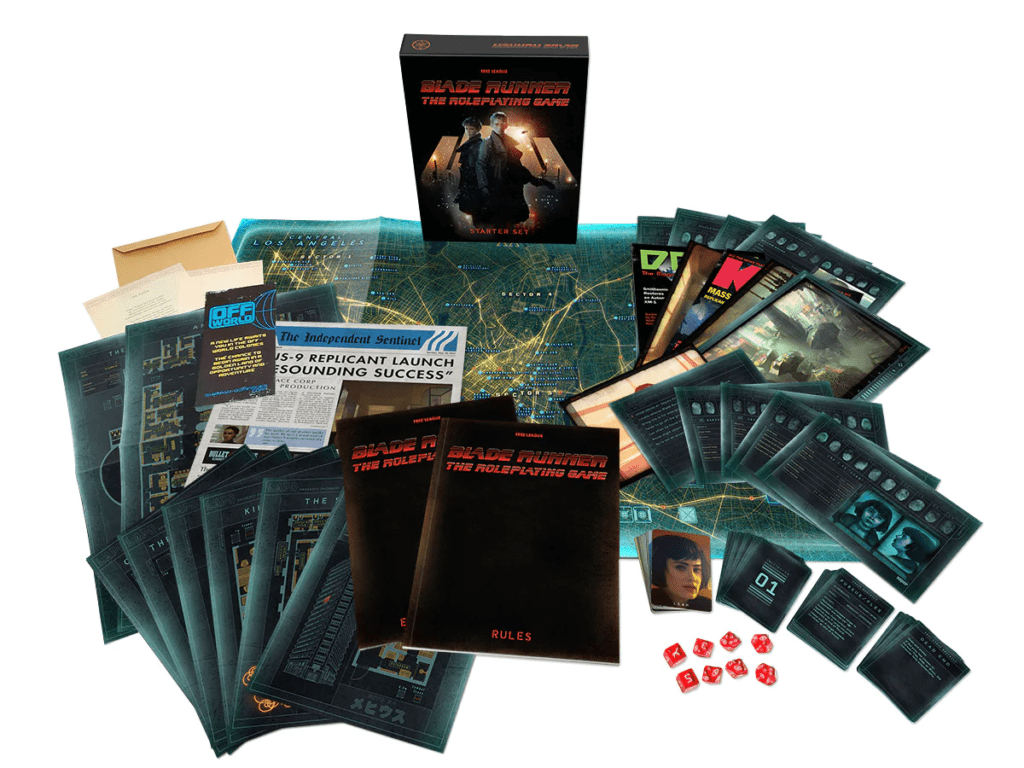
Blade Runner is a rather well-known and popular franchise and fans are remarkably loyal, so the bar is set pretty high here. Taking place well after the first movie and before the second, things are predictably dystopian in the Los Angeles of 2037. Nexus-9 replicants are nearly impossible to distinguish from normal humans and some are even Blade Runners themselves. It’s into this crumbling high-tech civilization that you need to inject a bit of order, whether it be retiring an older model replicant or taking down some human garbage.
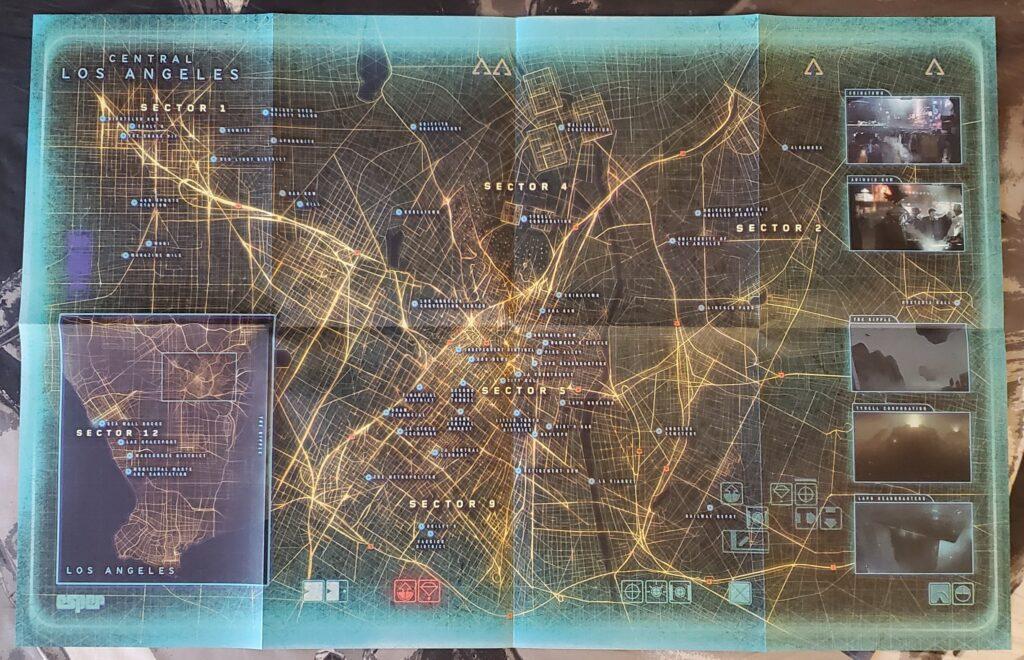
It’s hard not to make comparisons to other TTRPGs, notably the granddaddy of them all, Dungeons & Dragons, so let’s get that out of the way first. While Blade Runner isn’t unique per se, it’s also nothing like a traditional TTRPG. In D&D, your job is typically to fight your way through problems, traps, and mazes to take out a big baddie or solve a problem at the end. Blade Runner is structured quite differently. Instead of fighting and carousing, your job is to solve a case, often by whatever means necessary, extra-legal or not. That might be a murder, a riot, a group of rogue replicants, whatever. In Electric Dreams, the first case file, at least one Blade Runner has been killed and it’s up to you to investigate…fast.
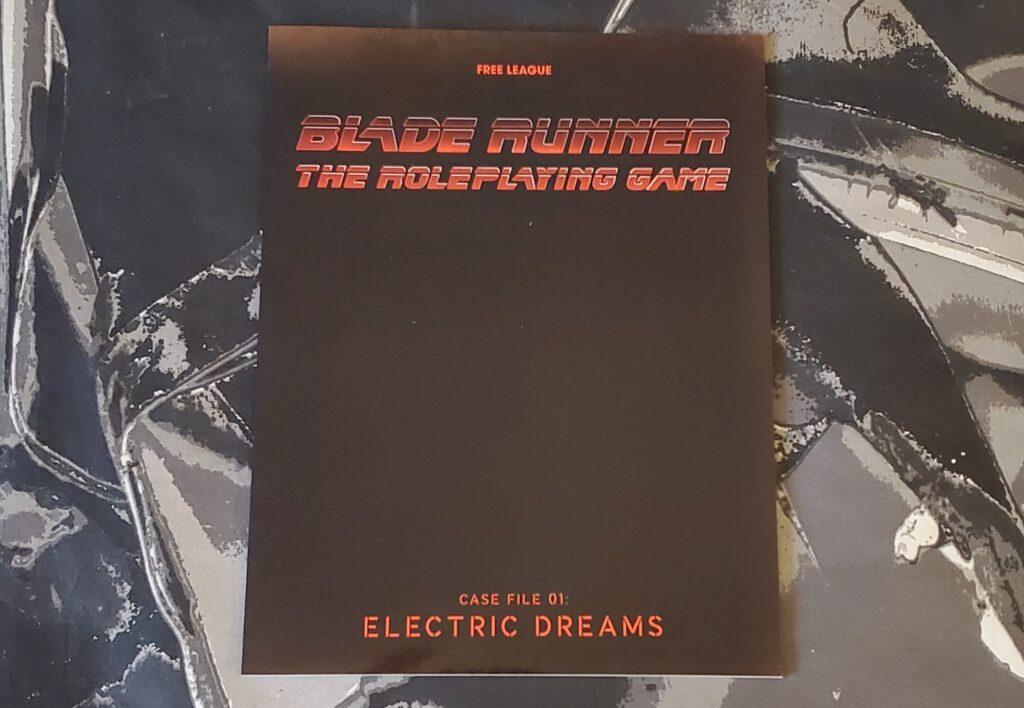
Blade Runner isn’t like other RPGs because instead of exploring, you’ve got a limited time to solve a case. Fail and the perp will get away, not only leaving you high and dry for the Chief, but also directly affecting your player stats on your character sheet! And investigating takes time. You have to travel to places, talk to people, do research, interrogate people, report in and more. Just like in the real world, you also need some downtime so after every three shifts of investigation, you’ll need to take a break and work on something your character would be likely to do.

What’s interesting about this format is that it forces players to play a deeper type of role-playing than they might in other TTRPGs. You need to stay in character in Blade Runner in a way that might challenge some players. You have to discuss the case and run theories, roll to intimidate people into talking, worry about how the stress of the job is impacting you, and a whole lot more. In fact, stress actually matters in Blade Runner and in addition to health, you’ll also have to manage your stress levels. Too much damage or stress leads to a ‘Broken’ Blade Runner, significantly incapacitating your character or in some cases, making them go crazy!
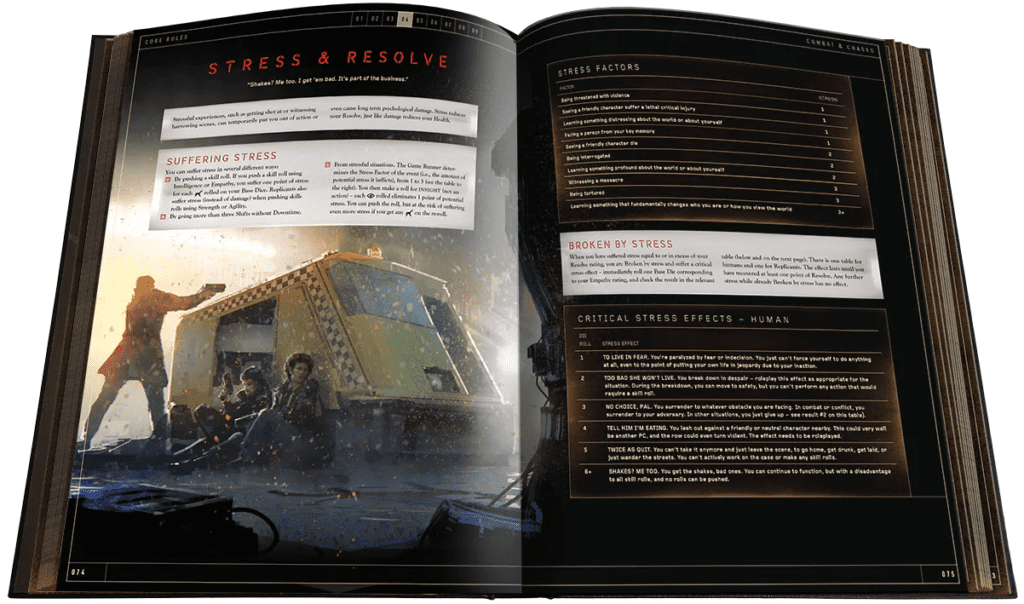
The other thing your game will need is a Game Runner. That’s equivalent to a Dungeon Master for you D&D fans out there. The Game Runner manages all the interactions and NPC dialogue, the enemies, and the entire scenario you’re playing. Blade Runner is a particularly detailed and imaginative TTRPG so you’ll need a Game Runner with some chops and more than a passing familiarity with the rules if you want a good game. Chances are you’ll want between 3-4 players including the Gamer Runner for a solid game.
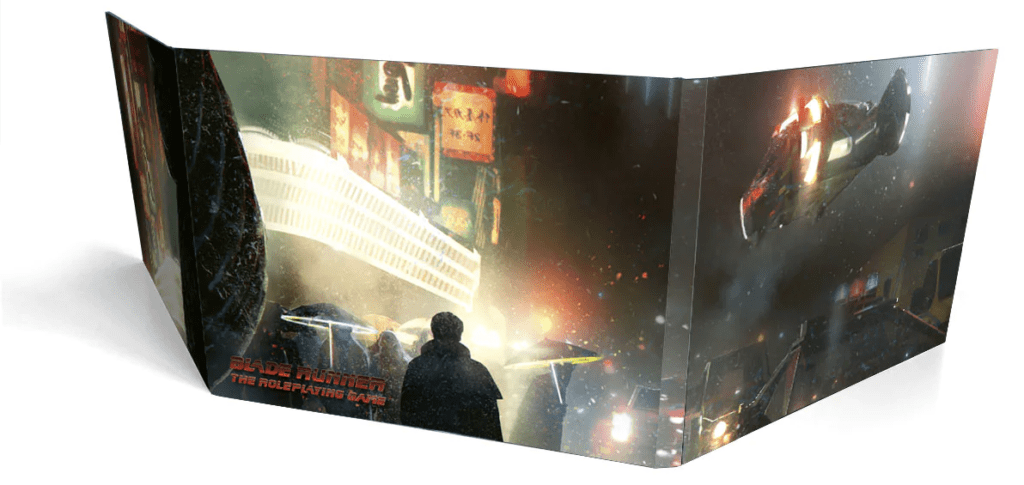
While you’re working your way through a case, whether it be Electric Dreams, a custom scenario, or one of the upcoming scenarios, you’ll also need to understand how combat works. Naturally, there’s no way to explain everything in a short review…that’s kind of why you buy the sourcebooks to begin with, but the main components are combat and chases. While both are key components, as you might expect by now combat doesn’t work the way it does in other games either. In fact, getting into fights in Blade Runner is something to be done sparingly and avoided if at all possible.
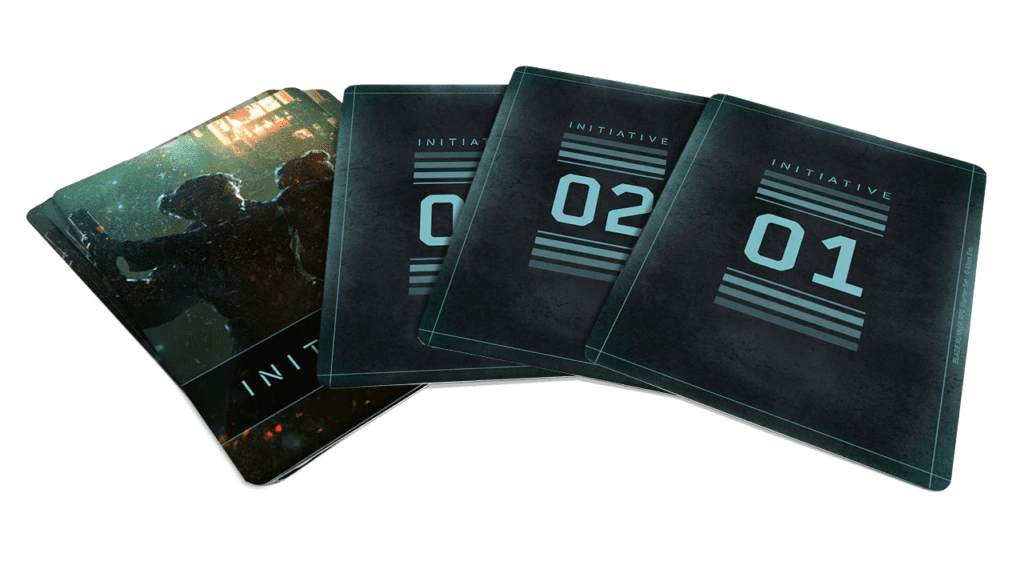
Combat is a series of opposed rolls with a player or NPC. The size of the dice you use D6-D12 depends on skill points established during character creation or gameplay. Initiative drawn at random determines who goes first. If you have the Starter Set, it comes with Initiative cards, allowing you to draw at random. Note that all of the cards in the Starter set have a tendency to stick together so card sleeves are definitely recommended! Once initiative is determined, distance becomes a factor. You can fight hand to hand or with weapons and each has specific rules and dice based on your stats and the weapon’s stats. You can even use vehicles in combat and there’s a full breakdown of how it works in both the sourcebook and the Start Set rules! Various situations and abilities can also provide advantages and disadvantages to die rolls, providing an extra point or taking one away at a critical juncture.

Again unlike other games, damage is low in Blade Runner. For example, one of the premade characters from Electric Dreams, William Novak, has 5 health points in total. If he takes 5 damage during combat, he’s Broken and depending on the situation, could even die. Fighting is definitely risky! If you roll a 6 or higher it’s a success, denoted by an eye on the dice that come with the Starter Set. If you get two more eyes than your opponent (or two more 6s if you’re using standard dice), you do critical damage. Criticals are very deadly in Blade Runner. You can also have a critical failure by rolling a 1 (designated by an origami unicorn of course), wildly throwing off whatever action you are performing.

Finally, there’s a cool mechanic called pushing. Characters in Blade Runner can vainly struggle against the odds even when all seems lost. These heroic actions are called pushing and allow you to reroll dice one time at a cost to your stress levels. If you’re in real trouble, you can sacrifice stress for a chance to succeed, but it’s certainly a risky proposal! If you’re in a bind though, a push might be the difference between life and death or success and failure. It also might riddle you with bullet holes.

Chasing is the other major mechanic in Blade Runner. Much like the movies, a chase through the rain-soaked streets is a major component of the drama of the game. Whether you’re in a car or on foot, you’ll have to pursue suspects and there’s a very real chance they could get away, leaving you empty-handed and explaining to the boss why you’ve failed and costing you promotion points.
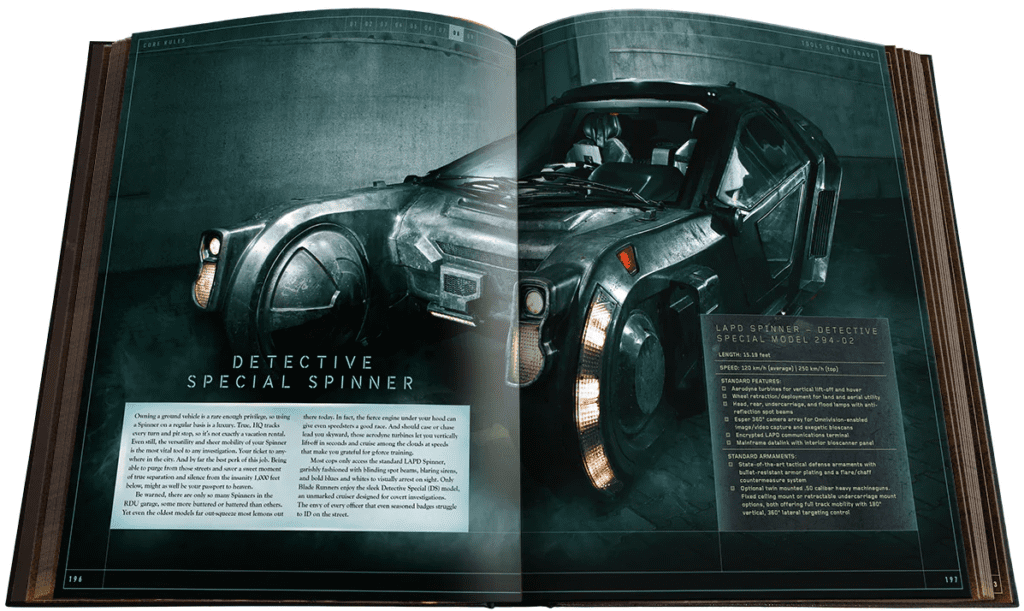
Chasing consists of following your quarry and avoiding obstacles that they put in your way. Close the distance on them as much as possible and either open fire or keep coming until you can attack directly. It’s a neat system and works just as well for spinners (cars) as it does for hand-to-hand combat. With the Starter Set, you’ll also get obstacle cards for foot chases, vehicle chases, and even aerial chases, but a Game Runner can always set up a table for the same specifics and roll a die as well. There’s a versatility built into Blade Runner that allows you to play whether you just have the Core Rules book or the whole shebang.
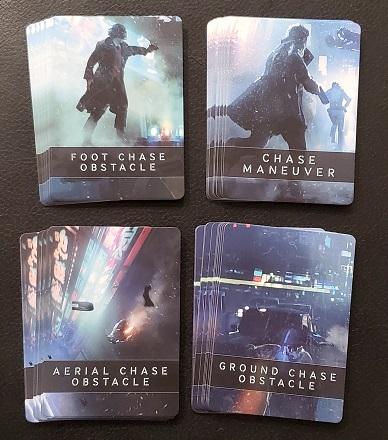
As you can see, there’s a lot of complexity here and things aren’t always what you’d expect. Making rolls to determine if you pick up details from photographic evidence or interrogating a suspect then beating them up, the choice is up to you. You can even work with people on the DL, informants, helpers, and even officials who can bend or break the rules if you’re careful. Just don’t get caught! For players, there are a lot of morality options here and that’s part of the appeal of Blade Runner in comparison to other RPGs. Here you’re really acting out the life of your character, living their off-duty time whether it be partying, reading, or even hitting a brothel. You’re investigating, trying to solve an actual case with a limited amount of time before you fail. And you might find out that there are mitigating circumstances in the course of your investigation, forcing you to make hard choices.

One of the hardest choices is whether or not to let someone go. Just because they broke the law doesn’t make them bad necessarily and while it’s your job to bring them in or retire them, you’re human too. Well, unless you’re a replicant, in which case you’re stronger, smarter, faster, and significantly less burdened by emotions. There’s actually a whole modified ruleset for replicants but you’ll read all about it in the sourcebook. At the end of each case you get promotion points which are similar to leveling up your character. However, you can fail or choose another pathway as well, forfeiting your promotional points and often gaining humanity points instead. These represent empathy with others and might be the better option in some cases. Remember, it’s up to you what kind of person or replicant you want to be.
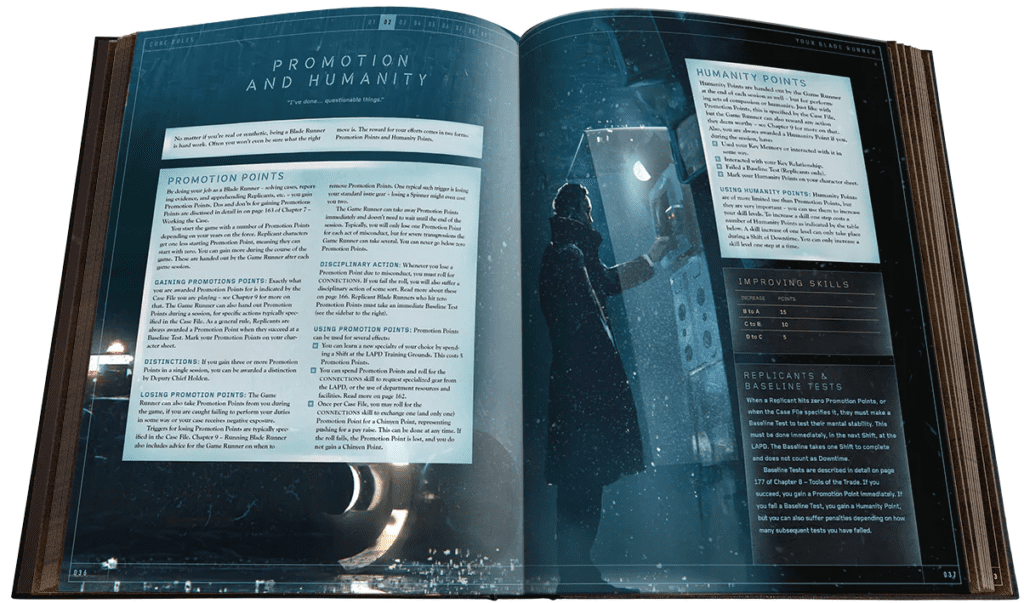
Finally, let’s look at the cost. The Core Rules book weighs in at $50, but it’s worth the money in terms of both quality and due to the fact that if your group is skilled, you could feasibly play the entire game with only the rules book. The Starter Set comes with the entire casefile for Electric Dreams, clues, maps, the whole nine yards, plus dice and cards and is $47, a pretty reasonable price considering the print quality! If you’re going all in, it’s cheaper to buy the RPG Rep Detect Bundle which includes both the Core Rules and the Starter Set as well as the $24 Game Runner Screen for $106 total. At that point, you’ll have absolutely everything you could possibly need for a few sessions and the first case is pretty fantastic! Honestly, the value for the money for any serious gaming group is pretty high here and the print and build quality of everything is legitimately excellent.
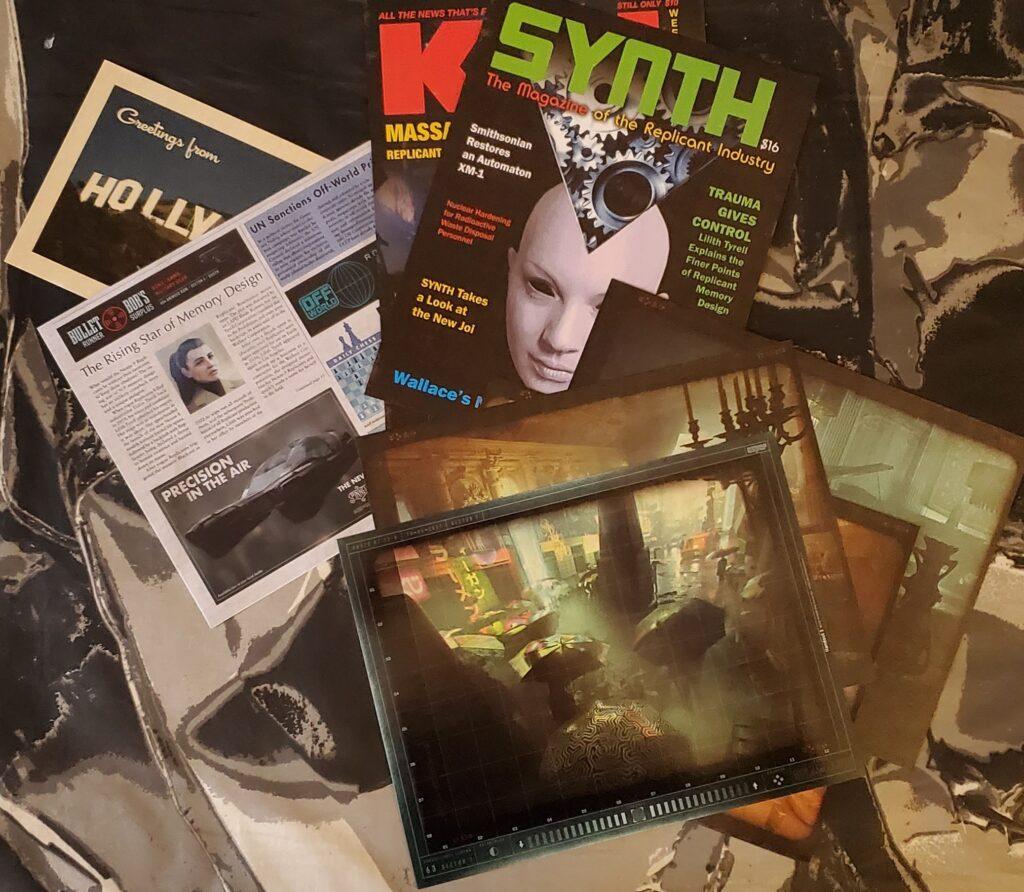
Blade Runner provides not only a deep role-playing experience that allows players to not only explore morality and our darker natures as human beings but also functions as a mystery-solving game. This complexity and heavier content level means that the game certainly isn’t intended for younger players of course. It also allows both new and veteran TTRPG gamers to explore the potential of the genre in a new and interesting way, delving into the facets of humanity through the lens of noir fiction. Playing Blade Runner makes you feel like you’re involved in the game in a way that other RPGs don’t necessarily manage and it’s a fantastic experience. But hey, don’t take our word for it…we might be replicants after all!

This review is based on a physical RPG Rep Detect Bundle of Blade Runner: The Roleplaying Game provided by the publisher. Care has been taken to evaluate both the physical items included in this bundle and the mechanics of the game. Blade Runner: The Roleplaying Game is available directly from Free League here, as well as at fine game stores everywhere.

